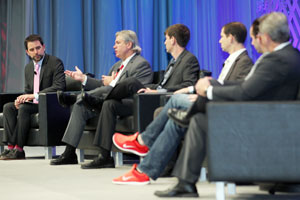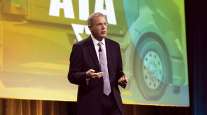Panelists Say Driverless Trucks Decades Away; Platooning Pairs Coming in 2017

Several state governments are eager to facilitate this technological leap in freight delivery, and a tech developer with Uber said the company will start by the end of the year a venture to make freight delivery more efficient.
This and lots of details on platoon and autonomous vehicles came out of an Oct. 4 Transport Topics panel discussion at the Management Conference & Exhibition of American Trucking Associations.
Executives from Daimler Trucks North America, Peloton Technology and Uber were joined by a Nevada Department of Motor Vehicles official and a North American Council for Freight Efficiency analyst to give fleet executives in attendance an idea of what’s coming to the industry.
Anthony Levandowski, a founder of Otto, now a division of Uber, offered the most futuristic vision of freight and technology: trucks that don’t need drivers. Just as operators were once required to run elevators and complete telephone calls, Class 8s could follow the same path.
STILL HAVE QUESTIONS? Send in now for Oct. 19 LiveOnWeb
“Many years from now trucks won’t have a cab,” Levandowski said.
He acknowledged, though, that could be 20 to 30 years in the future.
Josh Switkes, CEO and founder of Peloton Technology, said his company will bring two-truck platoons to U.S. highways sometime next year.
While multitruck platoons are possible, Switkes said he wants to start with pairs that would be connected with wireless links similar to Wi-Fi, only more reliable. Each truck would have a driver and the second truck would follow behind by 40 to 50 feet.
Backed by supporters such as Volvo Group and UPS Inc., Switkes said the arguments in favor of platooning are fuel efficiency from reduced aerodynamic drag and improvements in safety. Brake reaction time falls to 0.03 second with active safety systems, Switkes said, compared to 1.5 seconds for a person.
Not only are platoon trucks connected to each other, but to the Cloud, which provides supervision.
“We only platoon when it’s safe and where it’s safe,” Switkes said.
Sean Waters of DTNA and Nevada official Jude Hurin talked about how Freightliner came to the Silver State to develop Freightliner’s Inspiration truck that features autonomous assistance.
Waters said Daimler could have gone to a state without any regulation of testing, “but we did it where there were tough regulations. We wanted to be challenged.”
Nevada’s Hurin said Gov. Brian Sandoval, a Republican, is eager to diversify the economy.
“We’re not just gambling and mining. The governor is huge on technology,” Hurin said in an interview after the panel.
Trucking journalist Jack Roberts wrote a report on platooning for the North American Council for Freight Efficiency. He found that both trucks saw their miles per gallon increase because of platooning, by about 4% for the lead vehicle and 8% for the following one.
He said the autonomous braking is faster than a human can perform and that trucks made by different brands and used by different fleets should be able to communicate with each other.



